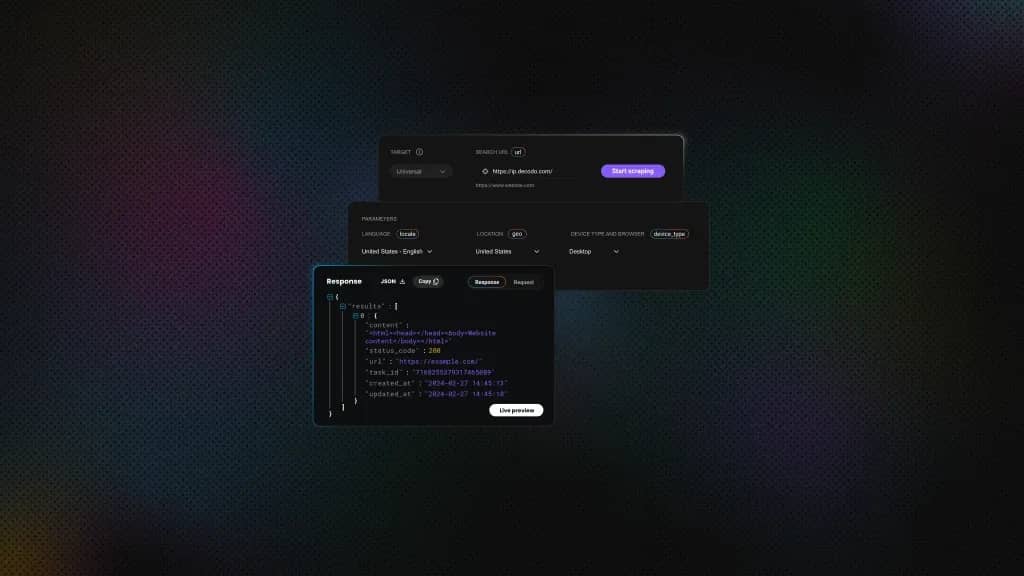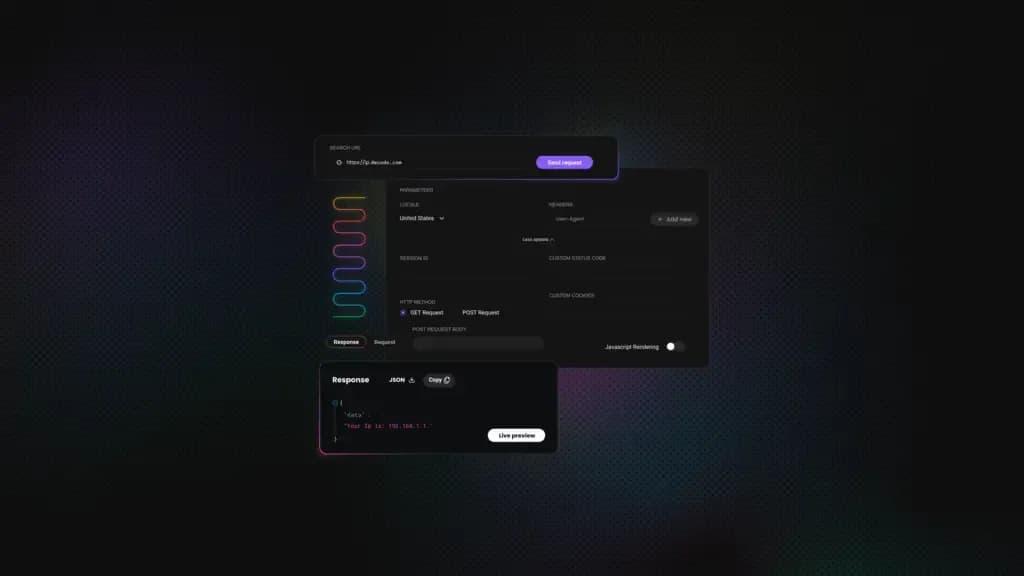Ultimate Guide to Error 1020: Causes, Fixes, and Prevention
When the website's firewall security settings block your request, Error 1020 will appear. This means that the restriction has been enforced even before your device gets to the website. People using automation tools, website administrators, and ordinary internet users encounter this problem. This post will help you understand what causes it and how to fix it.
Justinas Tamasevicius
Aug 12, 2025
8 min read

Why does Error 1020 occur?
Cloudflare's Web Application Firewall (WAF) targets and filters incoming traffic. If your request breaks any of those rules, WAF will block it, and you will get Error 1020.
Common triggers:
- Suspicious or automated activity. Scraping bots that go through websites too fast will be promptly flagged.
- Blocked IP addresses or regions. If a VPN or IP address from a prohibited country is identified, the system can simply deny access.
- Rate limiting and repeated requests. Too many simultaneous requests can lead to blocking.
- Misconfigured security settings. If the firewall rule is too generic, it will block legitimate users.
- False positives. Behaviors in regular traffic that resemble those of malicious actors may also trigger the error.
What does Error 1020 look like?
Error pages typically consist of the following elements:
- "Error 1020" or "Access Denied."
- Ray ID (Unique identification number for each request)
- The exact time and date when the website was blocked
The website may employ specific techniques, such as responding with a CAPTCHA, redirecting requests, or not responding at all. Sometimes, they are part of a multi-pronged approach designed to stop malicious traffic before it reaches the target system. A suspicious website may require a CAPTCHA or redirect the user to a different page, such as a warning or terms of use. Non-responsiveness is often employed to thwart automated scanning tools, which require feedback to adjust their approach. Each of these strategies aims to slow down or stop the unwanted traffic while still making it possible for legitimate users to access the network when needed.
Step-by-step solutions for site visitors
If you encounter Error 1020 while browsing, you should aim to find out whether the issue is temporary, something you can fix on your end, or a problem that only the website owner can resolve.
Step 1. Try to fix it on your own
- Refresh the page. Sometimes, a brief network glitch or a momentary alteration in the site's firewall settings can cause a block. If you wait for a few seconds before refreshing the page, you will not send repeated requests, which might prolong the restriction.
- Clear cookies and cache. The data stored in your browser might have old session identifiers or any other flag that causes the block. When they are removed, a brand-new TLS handshake is initiated between the website and browser.
- Try another device or network. Use mobile data instead of Wi-Fi or a different device and browser (remember to clear cookies) to test various settings.
- Try incognito mode. Launch your browser in incognito/private mode, which uses no extensions and cached data.
Step 2. Contact the site owner
If the above options don't yield results, reach out to the website's owner or their support staff. A precise report makes it easier for the IT or security team to act fast. Gather information below before contacting:
- Ray ID from the error page
- A screenshot with the message
- The time the error happened
- Optional: The browser name and version, the type of operating system you are using, and whether you were connected to the internet via a VPN, proxy service, or corporate network can be helpful.
The admin can then review their Cloudflare logs to identify the specific firewall rule that was triggered and determine if your request was legitimate.
Step 3. Avoid blocks preemptively
Avoid specific actions that can trigger the block. Rapidly changing VPN locations, using multiple free proxies (use Decodo's proxies instead), or incessantly refreshing a page can cause the traffic to appear suspicious and lead to a more extended or permanent ban. Instead, stop what you are doing, apply the solutions discussed above, and wait for feedback from the website owner. By being courteous, you lower the chances of account deletion and keep the door open for a speedy resolution.
Advanced fixes for developers & scrapers
If you are using any automation or web scraping tool, the error will most likely occur. To minimize this risk, adhere to the following:
- Rotate proxies. Use premium residential IPs. It is better to avoid free or public lists of proxies.
- Rotate user-agent headers. Ensure the tool does not recognize the text or content patterns being sent in the request. Implement stealth plugins and employ undetectable browser drivers.
- Mask automation tools. Use stealth plugins and undetected browser drivers like Puppeteer or Playwright.
- Add delays between requests. Space out the requests by adding time intervals between them. Refrain from sending multiple inquiries at once.
- Use scraping APIs. Integrate scraping APIs, such as Decodo's Web Scraping API, to extract data.
Ethical scraping matters
Always check and respect the target website’s robots.txt file, which specifies the website sections that automated tools are permitted or prohibited from accessing. When a tool disobeys the website's instructions, it's easily detected and blocked. By staying in the allowed areas, you will not trip any security mechanisms put in place to prevent unauthorized access.
Troubleshooting for website owners & admins
If users complain about Error 1020, look into the following:
- Check Firewall logs. To view the Firewall logs, go to Cloudflare > Security > Events and search by Ray ID or IP.
- Identify the blocking rule. Determine what rule blocked the website by looking at the conditions, such as country, user agent, or path.
- Adjust the rule. Adjust a rule to narrow its scope or change it from "Block" to "Challenge".
- Whitelist IPs if safe. Verify that the traffic source originates from internal tools, partners, or known users.
False positives vs real threats
Blocked requests are not necessarily malicious. Before omitting or altering a rule, the context and frequency of the issue should be considered.
When to contact Cloudflare support
If you suspect the problem is more intricate, contact Cloudflare's support for assistance.
Balancing security with accessibility
Website owners need to find the right balance between site safety and accessibility. Excessive security will lock out users, affect conversions, and erode brand trust. Inadequate protection will leave the website vulnerable to malicious attacks. This section will explore how businesses can maintain robust security measures without compromising usability.
Risks of overly strict firewall rules
When entire countries or specific user agents are blocked, legitimate users will have serious accessibility issues. Users may be unable to log into the website, complete purchases, use account features, or view basic content. Moreover, companies lose their reputation when customers are unable to access the websites and products they have paid for.
Dangers of disabling Cloudflare protections
When a domain is set to DNS-only, it bypasses all the protection offered by Cloudflare. Consequently, your server becomes vulnerable to various online threats such as DDoS floods, probing attacks, and malicious bot traffic. When the system is out of reach, server resources can be overwhelmed in seconds, increasing the danger of data loss as hackers may obtain sensitive information from the servers.
Best practices
Let's look at some of the best practices a website should observe for effective security without compromising user experience.
- Use preview mode before deploying new rules. This capability enables you to refine the precision of your rules by monitoring how they would behave without jeopardizing real users.
- Monitor WAF logs regularly for unusual blocks. Regular log analysis can reveal trends such as frequent false positives or new attack techniques before they escalate into major issues.
- Challenge rather than block risky but uncertain traffic. A CAPTCHA or JavaScript challenge can be shown to a visitor instead of restricting access. It stops most bots dead in their tracks while allowing legitimate users to pass through.
- Whitelist known trusted traffic where necessary. The firewall should allow trusted IP ranges to bypass security checks.
- Regularly review and update firewall settings. Do it to ensure they conform to your risk tolerance. When the business model, user base, and threat landscape change, the old rules may become obsolete. Regular auditing ensures the policies are updated and effective.
Conclusion
Error 1020 means that the request you sent was blocked by a firewall rule on the site using Cloudflare. It's a feature, not a bug. If you are just a visitor, try switching networks or clearing the cache. Website owners should also refine firewall settings and logging to enhance the user experience. The emphasis should be on ethical and well-camouflaged scraping. To avoid exclusion, a user should be aware of what triggers the wall.
About the author

Justinas Tamasevicius
Head of Engineering
Justinas Tamaševičius is Head of Engineering with over two decades of expertize in software development. What started as a self-taught passion during his school years has evolved into a distinguished career spanning backend engineering, system architecture, and infrastructure development.
Connect with Justinas via LinkedIn.
All information on Decodo Blog is provided on an as is basis and for informational purposes only. We make no representation and disclaim all liability with respect to your use of any information contained on Decodo Blog or any third-party websites that may belinked therein.

